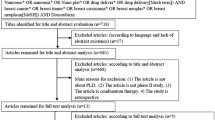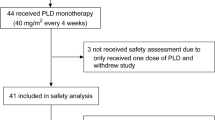Abstract
Purpose
Pegylated liposomal doxorubicin (PLD) is used to treat patients with breast and gynecological cancers. In order to optimize treatment with PLD, we assessed the prognostic and predictive factors for efficacy of PLD.
Methods
Seventeen patients treated with PLD 30 or 40 mg/m2 underwent pharmacokinetic sampling during the first cycle of treatment. PLD exposure was calculated. An univariate analysis was performed with the variables: hand–foot syndrome, mucositis, rash, neutropenia, age, tumor type, number of previous therapies, ECOG performance status and progression-free survival (PFS). Candidate variables with p ≤ 0.1 were selected for the multivariate analysis.
Results
Based on the results of the multivariate analysis, the PLD exposure (log AUC) was higher in patients who experienced rash (p = 0.002) and mucositis (p = 0.001) compared to those who did not have these adverse events. The development of hand–foot syndrome was significantly related to a lower risk of disease progression (HR 0.1; 95 % CI 0.02–0.64). Patients with an ECOG status of 0 had a longer PFS than the patients with an ECOG status of 1 (HR 5.4; 95 % CI 1.3–22.8). Moreover, PLD exposure (ln AUC) was also positively related to PFS (HR 0.001; 95 % CI 0.00–0.42).
Conclusions
The extent of the exposure to PLD was correlated with more adverse events and longer PFS. This has important clinical implications, since dose reductions or interruptions might thus negatively affect treatment outcomes. More attention should be paid to preventive and supportive measures of adverse events of PLD to keep the exposure to PLD as high as possible.

Similar content being viewed by others
References
Gordon AN, Fleagle JT, Guthrie D, Parkin DE, Gore ME, Lacave AJ (2001) Recurrent epithelial ovarian carcinoma: a randomized phase III study of pegylated liposomal doxorubicin versus topotecan. J Clin Oncol 19:3312–3322
Gordon AN, Tonda M, Sun S, Rackoff W (2004) Long-term survival advantage for women treated with pegylated liposomal doxorubicin compared with topotecan in a phase 3 randomized study of recurrent and refractory epithelial ovarian cancer. Gynecol Oncol 95:1–8
Keller AM, Mennel RG, Georgoulias VA, Nabholtz J-M, Erazo A, Lluch A, Vogel CL, Kaufmann M, von Minckwitz G, Henderson IC, Mellars L, Alland L, Tendler C (2004) Randomized Phase III Trial of Pegylated Liposomal Doxorubicin Versus Vinorelbine or Mitomycin C Plus Vinblastine in Women With Taxane-Refractory Advanced Breast Cancer. J Clin Oncol 22:3893–3901
Muggia FM, Blessing JA, Sorosky J, Reid GC (2002) Phase II trial of the pegylated liposomal doxorubicin in previously treated metastatic endometrial cancer: a Gynecologic Oncology Group study. J Clin Oncol 20:2360–2364
Cianfrocca M, Lee S, Von Roenn J, Tulpule A, Dezube BJ, Aboulafia DM, Ambinder RF, Lee JY, Krown SE, Sparano JA (2010) Randomized trial of paclitaxel versus pegylated liposomal doxorubicin for advanced human immunodeficiency virus-associated Kaposi sarcoma: evidence of symptom palliation from chemotherapy. Cancer 116:3969–3977
Ranson MR, Carmichael J, O’Byrne K, Stewart S, Smith D, Howell A (1997) Treatment of advanced breast cancer with sterically stabilized liposomal doxorubicin: results of a multicenter phase II trial. J Clin Oncol 15:3185–3191
Charrois GJ, Allen TM (2003) Multiple injections of pegylated liposomal doxorubicin: pharmacokinetics and therapeutic activity. J Pharmacol Exp Ther 306:1058–1067
Lyass O, Uziely B, Ben-Yosef R, Tzemach D, Heshing NI, Lotem M, Brufman G, Gabizon A (2000) Correlation of toxicity with pharmacokinetics of pegylated liposomal doxorubicin (Doxil) in metastatic breast carcinoma. Cancer 89:1037–1047
Uziely B, Jeffers S, Isacson R, Kutsch K, Wei-Tsao D, Yehoshua Z, Libson E, Muggia FM, Gabizon A (1995) Liposomal doxorubicin: antitumor activity and unique toxicities during two complementary phase I studies. J Clin Oncol 13:1777–1785
Amantea MA, Forrest A, Northfelt DW, Mamelok R (1997) Population pharmacokinetics and pharmacodynamics of pegylated-liposomal doxorubicin in patients with AIDS-related Kaposi’s sarcoma. Clin Pharmacol Ther 61:301–311
Gabizon A, Tzemach D, Mak L, Bronstein M, Horowitz AT (2002) Dose dependency of pharmacokinetics and therapeutic efficacy of pegylated liposomal doxorubicin (DOXIL) in murine models. J Drug Target 10:539–548
European Medicines agency. Scientific discussion for Caelyx [online]. http://www.emea.europa.eu/docs/en_GB/document_library/EPAR_-_Scientific_Discussion/human/000089/WC500020175.pdf
European Medicines Agency. Summary of product characteristics Caelyx. http://www.emea.europa.eu/docs/en_GB/document_library/EPAR_-_Product_Information/human/000089/WC500020180.pdf
Boers-Sonderen MJ, de Geus-Oei LF, Desar IM, van der Graaf WT, Oyen WJ, Ottevanger PB, van Herpen CM (2014) Temsirolimus and pegylated liposomal doxorubicin (PLD) combination therapy in breast, endometrial, and ovarian cancer: phase Ib results and prediction of clinical outcome with FDG-PET/CT. Target Oncol [Epub ahead of print]
Common Terminology Criteria for Adverse Events version 3.0. http://ctep.cancer.gov/protocoldevelopment/electronic_applications/docs/ctcaev3.pdf
Eisenhauer EA, Therasse P, Bogaerts J, Schwartz LH, Sargent D, Ford R, Dancey J, Arbuck S, Gwyther S, Mooney M, Rubinstein L, Shankar L, Dodd L, Kaplan R, Lacombe D, Verweij J (2009) New response evaluation criteria in solid tumours: revised RECIST guideline (version 1.1). Eur J Cancer 45:228–247
Chin DL, Lum BL, Sikic BI (2002) Rapid determination of PEGylated liposomal doxorubicin and its major metabolite in human plasma by ultraviolet-visible high-performance liquid chromatography. J Chromatogr, B: Anal Technol Biomed Life Sci 779:259–269
de Bruijn P, Verweij J, Loos WJ, Kolker HJ, Planting AS, Nooter K, Stoter G, Sparreboom A (1999) Determination of doxorubicin and doxorubicinol in plasma of cancer patients by high-performance liquid chromatography. Anal Biochem 266:216–221
Briasoulis E, Karavasilis V, Tzamakou E, Rammou D, Soulti K, Piperidou C, Pavlidis N (2004) Interaction pharmacokinetics of pegylated liposomal doxorubicin (Caelyx) on coadministration with paclitaxel or docetaxel. Cancer Chemother Pharmacol 53:452–457
Gabizon A, Isacson R, Rosengarten O, Tzemach D, Shmeeda H, Sapir R (2008) An open-label study to evaluate dose and cycle dependence of the pharmacokinetics of pegylated liposomal doxorubicin. Cancer Chemother Pharmacol 61:695–702
Northfelt DW, Martin FJ, Working P, Volberding PA, Russell J, Newman M, Amantea MA, Kaplan LD (1996) Doxorubicin encapsulated in liposomes containing surface-bound polyethylene glycol: pharmacokinetics, tumor localization, and safety in patients with AIDS-related Kaposi’s sarcoma. J Clin Pharmacol 36:55–63
Gabizon A, Catane R, Uziely B, Kaufman B, Safra T, Cohen R, Martin F, Huang A, Barenholz Y (1994) Prolonged circulation time and enhanced accumulation in malignant exudates of doxorubicin encapsulated in polyethylene-glycol coated liposomes. Cancer Res 54:987–992
Xu L, Wang W, Sheng YC, Zheng QS (2010) Pharmacokinetics and its relation to toxicity of pegylated-liposomal doxorubicin in Chinese patients with breast tumours. J Clin Pharm Ther 35:593–601
Thornton KA, Chen AR, Trucco MM, Shah P, Wilky BA, Gul N, Carrera-Haro MA, Ferreira MF, Shafique U, Powell JD, Meyer CF, Loeb DM (2013) A dose-finding study of temsirolimus and liposomal doxorubicin for patients with recurrent and refractory bone and soft tissue sarcoma. Int J Cancer 133:997
Robert J (1993) Use of pharmacokinetic-pharmacodynamic relationships in the development of new anthracyclines. Cancer Chemother Pharmacol 32:99–102
Hong RL, Tseng YL (2003) A phase II and pharmacokinetic study of pegylated liposomal doxorubicin in patients with advanced hepatocellular carcinoma. Cancer Chemother Pharmacol 51:433–438
Qin S, Jin J, Guo J, Wang J-W, Zhou F-J, Huang Y-R, Ren X-B, Ye D-W, Pan S, Sajben P, Wang Q (2013) Hand-foot syndrome (HFS) and asthenia/fatigue (A/F) as biomarkers of sunitinib efficacy in Chinese patients (pts) with metastatic renal cell carcinoma (mRCC). J Clin Oncol 31:(suppl; abstr e15622)
Cameron DA, Massie C, Kerr G, Leonard RC (2003) Moderate neutropenia with adjuvant CMF confers improved survival in early breast cancer. Br J Cancer 89:1837–1842
Giovannini M, Gregorc V, Belli C, Roca E, Lazzari C, Vigano MG, Serafico A, Villa E (2009) Clinical significance of skin Toxicity due to EGFR-targeted therapies. J Oncol 2009:849051
Acknowledgments
This work was supported by the manufacturers of temsirolimus and PLD: Wyeth Pharmaceuticals, Pfizer bv, Schering Plough and Janssen-Cilag bv. These sponsors had no involvement in the study design, in the collection, analysis and interpretation of data, in the writing of the manuscript or in the decision to submit the manuscript for publication. Dr. Ottevanger and Dr. van Herpen have received funding from the manufacturers of temsirolimus and PLD to perform this study.
Conflict of interest
All other authors declare no conflict of interests.
Author information
Authors and Affiliations
Corresponding author
Rights and permissions
About this article
Cite this article
Boers-Sonderen, M.J., van Herpen, C.M.L., van der Graaf, W.T.A. et al. Correlation of toxicity and efficacy with pharmacokinetics (PK) of pegylated liposomal doxorubicin (PLD) (Caelyx®). Cancer Chemother Pharmacol 74, 457–463 (2014). https://doi.org/10.1007/s00280-014-2514-9
Received:
Accepted:
Published:
Issue Date:
DOI: https://doi.org/10.1007/s00280-014-2514-9




